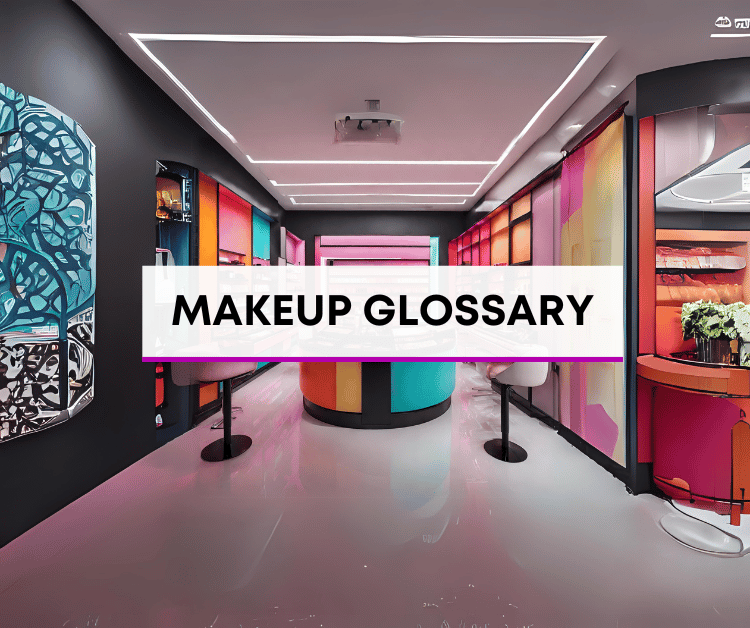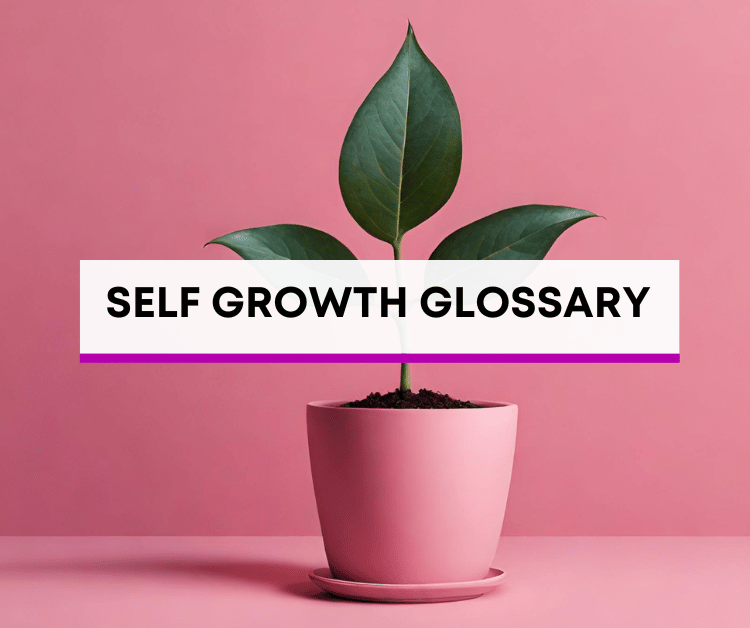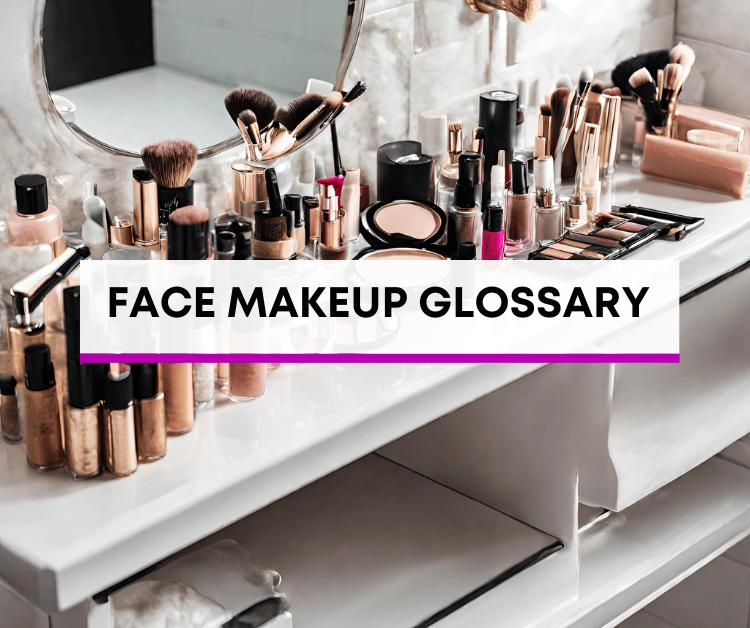
Crafted from my own experience as a makeup enthusiast and artist, this makeup glossary aims to be your ultimate guide to makeup terms. To keep it super simple, it’s divided into three essential categories:
- Basic Makeup Products
- Basic Makeup Tools
- Basic Makeup Techniques
This list is here to help you learn the lingo, and ultimately help you feel more comfortable and confident when talking about makeup.
Basic Makeup Products
- BB Cream: Multitasks as a moisturizer, sunscreen, and lightweight foundation.
- Blush: Adds a healthy flush to your complexion.
- Bronzer: Adds warmth and definition to your face.
- Brow Gel: Keeps brows in place with added definition.
- Color Corrector: Neutralizes discoloration for a flawless complexion.
- Concealer: Hides blemishes and imperfections for a flawless look.
- CC Cream: Corrects color and texture imperfections for a flawless finish.
- Eyebrow Pencil: Shapes and defines sparse brows for a polished look.
- Eyebrow Pomade: Sculpts and shades for bold brows.
- Eyebrow Powder: Adds depth and definition for natural-looking brows.
- Eyeliner: Defines eyes with color along the lash line.
- Eyeshadow: Adds color and dimension for endless eye looks.
- Eye Primer: Enhances eyeshadow pigmentation and longevity.
- Face Primer: Blurs imperfections and extends foundation wear.
- Foundation: Creates a flawless canvas with even coverage.
- Highlighter: Adds a luminous sheen to your best features.
- Lip Balm: Hydrates and nourishes for soft, smooth lips.
- Lip Gloss: Provides shine and hydration for irresistible lips.
- Lip Liner: Defines lips and prevents feathering for long-lasting color.
- Lipstick: Adds color and personality to your look.
- Liquid Foundation: Provides seamless coverage for a radiant complexion.
- Makeup Remover: Gently cleanses away makeup for a fresh face.
- Mascara: Lengthens, volumizes, and defines eyelashes.
- Powder: Locks makeup in place and controls shine.
- Primer: Preps skin and extends makeup wear.
- Setting Powder: Ensures makeup stays put all day.
- Setting Spray: Locks in makeup for a flawless finish.
- Stick Foundation: Offers convenient, buildable coverage.
- Tinted Moisturizer: Provides hydration and a hint of color.
- Translucent Powder: Sets makeup without adding extra color.
- Under-eye Concealer: Camouflages dark circles for a well-rested look.
- Waterproof Mascara: Withstands tears, sweat, and smudging.
Basic Makeup Tools
- Beauty Blender: A sponge used to apply and blend foundation, concealer, and other liquid or cream makeup products.
- Blush Brush: A brush with soft bristles designed for applying blush to the cheeks.
- Brow Brush: A brush with a spoolie on one end and an angled brush on the other, used for grooming and defining eyebrows.
- Eyebrow Razor: A small razor used to shape and groom eyebrows by removing stray hairs.
- Eyelash Curler: A tool used to curl the eyelashes before applying mascara for added lift and definition.
- Eyeliner Brush: A thin, angled brush used for precise application of eyeliner.
- Eyeshadow Brush: A brush designed for applying and blending eyeshadow on the eyelids.
- Foundation Brush: A brush with dense bristles used to apply and blend foundation onto the skin.
- Lash Comb: A fine-toothed comb used to separate and define eyelashes after applying mascara.
- Lip Brush: A small, precise brush used to apply lipstick or lip gloss for more controlled application.
- Makeup Sponge: A soft sponge used to apply and blend liquid and cream makeup products onto the skin.
- Powder Brush: A brush with fluffy bristles used to apply setting powder to the face.
- Spoolie Brush: A small brush used to groom and shape the eyebrows or separate eyelashes.
- Tweezers: Small, pointed tools used for precise hair removal or for applying false eyelashes.
Basic Makeup Techniques
- Baking: A technique where translucent powder is applied heavily to areas of the face and left to sit for a few minutes before dusting off, helping to set makeup and achieve a matte finish.
- Blending: The process of seamlessly combining different shades of makeup or products together to create a smooth transition between colors.
- Color Correcting: Using specific colored concealers or primers to neutralize or counteract unwanted undertones or discoloration on the skin.
- Contouring: Enhancing and defining the natural contours of the face by using darker shades to create shadows and lighter shades to highlight specific features.
- Cut Crease: A technique where a sharp, defined line is created in the crease of the eyelid using contrasting eyeshadow colors, often achieved with the help of tape or concealer.
- Draping: Applying blush or bronzer in a sweeping motion from the apples of the cheeks up towards the temples to sculpt and lift the face.
- Eyebrow Mapping: Using specific measurements and angles to determine the ideal shape and placement of the eyebrows before grooming or filling them in.
- Eyeliner Wing: Extending eyeliner beyond the outer corner of the eye to create a winged or cat-eye effect, adding lift and definition to the eyes.
- Eyeshadow Gradient: Blending multiple eyeshadow shades together to create a seamless gradient effect from light to dark across the eyelid.
- Foundation Matching: Selecting the correct shade and formula of foundation to match the skin tone and type, ensuring a natural and flawless finish.
- Highlighting: Applying a lighter shade of makeup or product to specific areas of the face to enhance features and add dimension and glow.
- Lip Liner Overlining: Extending the natural lip line with lip liner to create the illusion of fuller lips, often followed by filling in with lipstick or gloss.
- Makeup Layering: Applying makeup products in multiple thin layers rather than one thick layer to achieve buildable coverage and a more natural finish.
- Makeup Removal: Properly cleansing and removing makeup at the end of the day to prevent clogged pores, breakouts, and other skin issues.
- Neutral Smoky Eye: Creating a smoky eye makeup look using neutral shades like browns and taupes for a softer, more wearable effect.
- Priming: Preparing the skin with a primer before applying makeup to create a smooth canvas, improve longevity, and enhance the overall finish of the makeup.
- Setting Makeup: Applying setting powder or spray over makeup to lock it in place and prevent smudging, fading, or creasing throughout the day.
- Stippling: Using a stippling brush or sponge to apply foundation or other products in a dabbing motion to achieve an airbrushed finish.
- Sculpting: Using contouring and highlighting techniques to sculpt and define the features of the face, enhancing bone structure and creating dimension.
- Smudging Eyeliner: Softening and blending out eyeliner along the lash line with a brush or fingertip to create a softer, more diffused look.
- Spot Concealing: Applying concealer only to specific areas of the face where needed, such as blemishes or redness, for targeted coverage.
- Stamping Technique: Using a pressing motion to apply eyeshadow or pigment to the eyelid for intense color payoff and minimal fallout.
- Strobing: Applying highlighter to the high points of the face, such as the cheekbones, brow bones, and bridge of the nose, to achieve a radiant, dewy glow.
- Tightlining: Applying eyeliner directly to the waterline or tightline of the eyes to define the lash line and create the appearance of thicker, fuller lashes.
- Transitional Eyeshadow: Applying a mid-tone eyeshadow shade to the crease of the eyelid to create a seamless transition between lighter and darker colors.
- Underpainting: Applying a base layer of color or foundation to the skin before applying other makeup products to even out the complexion and provide a smooth canvas.
- Undereye Brightening: Using a concealer or corrector with a lighter shade than your skin tone to brighten and conceal dark circles under the eyes.
- Winged Eyeliner: Extending eyeliner beyond the outer corner of the eye in a winged or cat-eye shape to elongate and lift the eyes.
- X Technique: Using an X-shaped motion to blend or apply makeup products for even coverage and seamless blending.
- Y Technique: Using a Y-shaped motion to apply contour, blush, or highlighter to the face for a lifted and sculpted effect.
- Z Technique: Using a zigzag or back-and-forth motion to apply or blend makeup products for a diffused and blended finish.
Conclusion
In short, this makeup glossary gives you the essential words you need to feel empowered in beauty conversations.
From foundation to contouring, these terms help you express yourself confidently and understand makeup better.
So, embrace these words and let them be your guide to owning your beauty journey.



